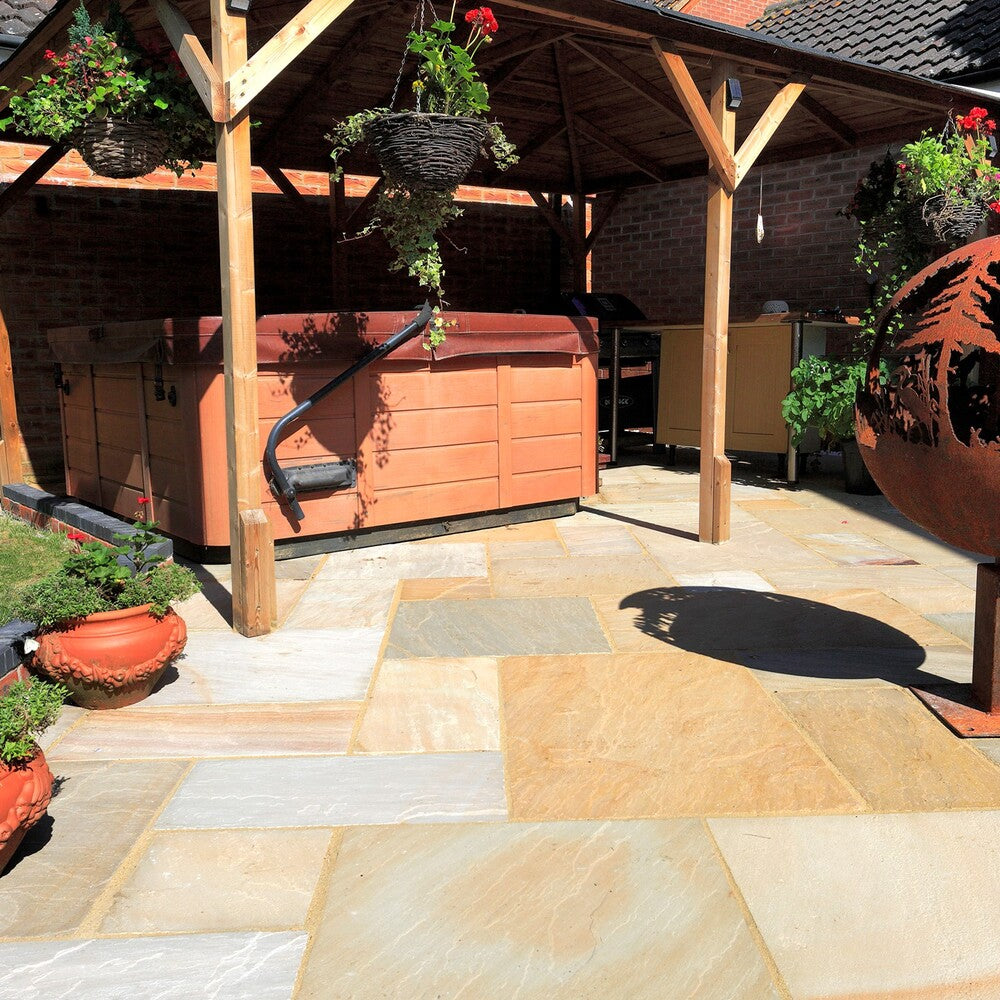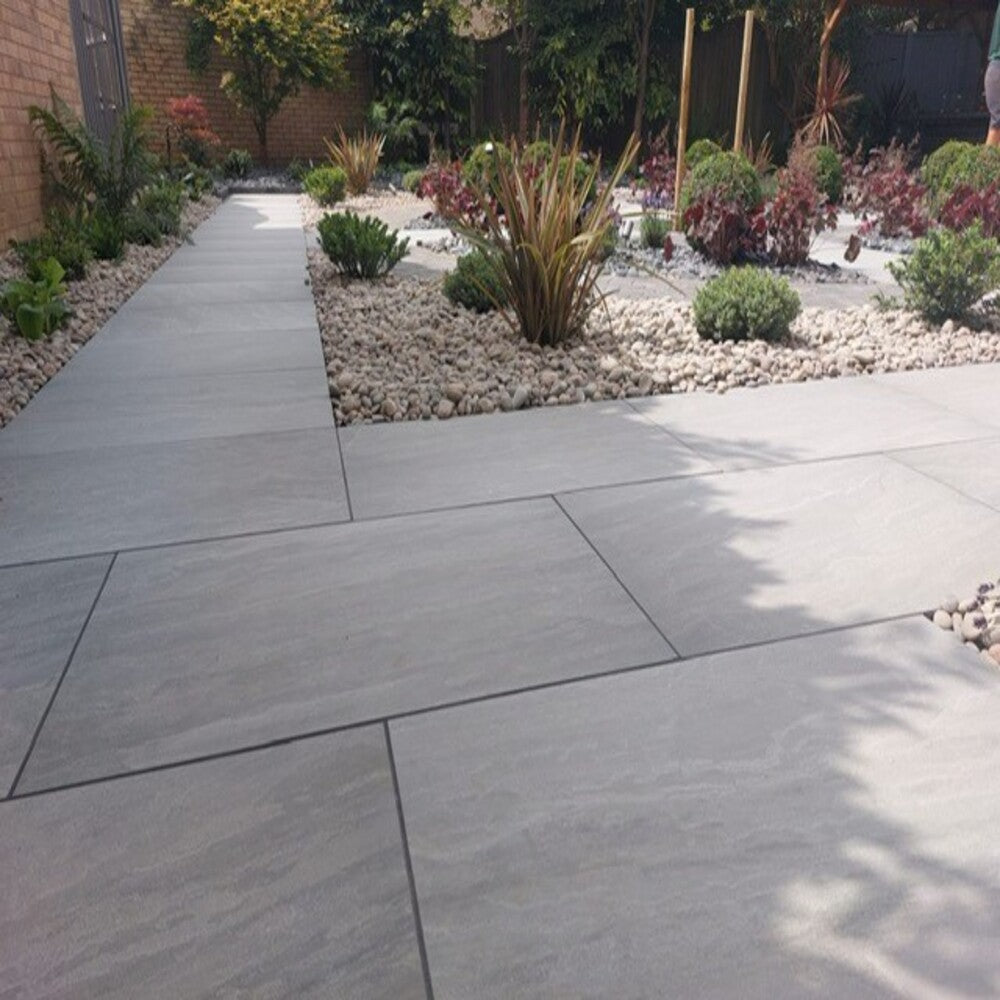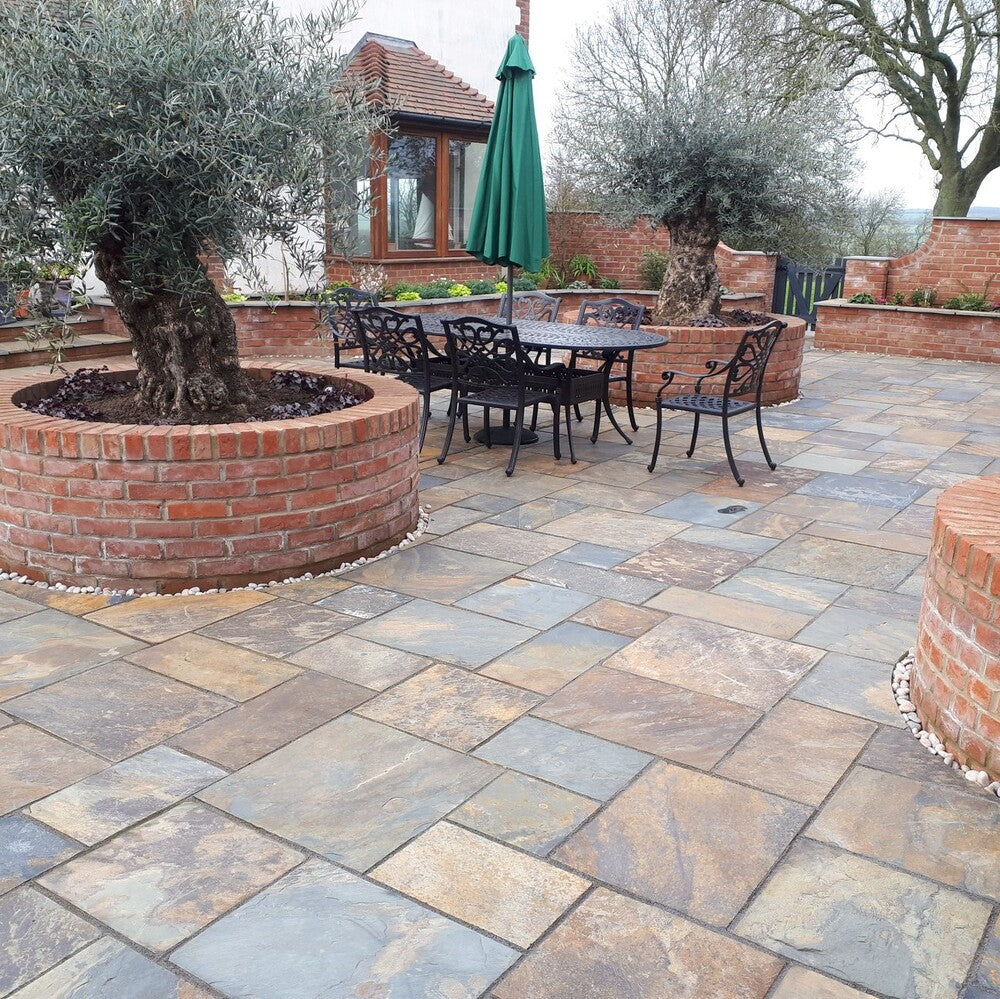This increasingly popular choice of sandstone paving gained popularity around a decade ago. A quick look up and down your street and the chances are you will spot a handful of properties with these slabs installed in their front gardens.
Read on and learn how sandstone paving became a favourite patio surface in the UK.
The History of Sandstone Paving
There are several reasons for the increase in popularity of sandstone paving slabs ranging from the colours, the price or simply the availability UK wide.
The rise of manufactured concrete paving
As people grew to care about how their outdoor spaces look, people started to use concrete paving slabs to create patio areas and other features to make their garden pop.
These concrete slabs were easy to produce en-masse, easy to regulate in terms of size and thickness and much more affordable than the alternatives at the time.
No affordable alternative
The only alternative was British quarried stone, which was at least double the price, irregular thicknesses and incredibly laborious to lay. Creating concrete slabs became a really strong process delivering great results – around 30 years ago.
The concrete slabs could be made up of so many textures and styles that you would struggle to tell the difference between them and the genuine article unless you had a really keen eye for it.
The arrival of a new natural stone: sandstone
Then suddenly, a global supply of sandstone began to reach the UK shores and natural stone paving was finally affordable to many who couldn’t afford the York stone that was so sought after.
The price of using a genuine stone paver to complete an outdoor space halved overnight in some cases. All of a sudden, you had masses of stone slabs arriving from India, China, Brazil – you name it – which were half the price of British York stone, cut in regular sizes and arriving in a beautiful array of colours.
The demand for such a product, which seemed lukewarm at best before this, sky-rocketed as people jumped at the chance to get a stylish, genuine stone patio at prices that were suddenly affordable.
Sandstone Paving - What is it and where does it come from?
A majority of the sandstone paving slabs that you see used in the UK comes from India. Sandstone paving slabs come under a handful of different names depending on the supplier.
There are quite a few different names from different suppliers, so just be aware that a fancy name does not necessarily mean that you are getting a superior product.
Merchants up and down the country stock varying qualities of the same stone but attempt to make it unique by jazzing up the name slightly. It’s important to look into the quality and not be drawn in by what seems like a fancy name.
So many of these sandstone paving slabs are now readily available in most parts of the UK, with a handful of companies even happy to ship UK wide, that it’s important to make yourself aware of exactly what you are purchasing.
Even though you are purchasing a product of the same name, there can be a huge gulf in quality between slabs from different suppliers.
So it’s important to know how to do a quality check to your sandstone slabs.
Bear in mind that:
- Sandstone is made up of grains of sand held together by a silicon based ‘cement’.
- It’s this 'cement' that gives the sandstone is various colours, textures and toughness.
- The weaker this cementitious material is, the worse quality of the stone.
How do you check the quality of sandstone?
- Rub the stone between your fingers. (the really poor-quality materials will be very weakly compacted and will noticeably fall apart)
- Check if it crumbles easily and leaves a sandy residue on your fingers.
This is a quick check you can do to rule out the bottom of the barrel stuff immediately! Although the quality of available sandstone has been increasing over the years, avoid merchants out there that offer poor quality materials.
Characteristics & Variations of Sandstone Paving Slabs
Sandstone is a fantastic material to work with and as a result there are a whole bunch of variations and styles that you can get sandstone paving slabs in.
There are so many in fact, that you can get quite confused with it all, so it’s important to know just what the different things mean. You can get variations in:
- Sizes
- Thickness
- Edge Type
- Surface Finish
Sandstone Paving: What are the different slab sizes?
The first thing that it pays to be aware of is the different sizes that slabs themselves will come in. There are two common ranges of slabs that are available to purchase:
The 60 series
- 900mm x 600mm
- 600mm x 600mm
- 600mm x 300mm
- 600mm x 450mm
- 300mm x 300mm
The 56 series
- 840mm x 560mm
- 560mm x 560mm
- 560mm x 420mm
- 560mm x 280mm
- 280mm x 280mm
These ‘series’ are designed to be laid together with a common multiple so they can be laid fairly logically, minimising the risk of there being an odd pattern.
In the depths of the supplier market, there are some that will sell boxes of straight-up quarry rejects in sizes like 760x590, 550x360 and 880x720 with seemingly no way to fit these together without making lots of cuts.
As a result, you may end up with paving that will look absolutely shocking anyway. This is the first thing to look out for, anything but the above two size options should be struck off immediately unless working with a single size - then it doesn’t matter so much.
As for the difference between the two, the 60 series in our opinion is a slightly better option for everyone. The 56 series is normally made up of 5 different slab sizes, compared to the 4 different sizes of the 60 series. The slabs within the 60 series cover more area per slab, meaning there is less labour involved in laying.
In the short-term, the price per pack is cheaper on the 56 series, but they will take longer to install. Meaning you may be costing yourself time and money in the long-term by going for a 60 series.
While the 56 series isn’t a terrible option – it’s certainly better than the random options that you can find out there – we would always recommend the 60 series as the better option.
How thick is Indian Sandstone?
This is the most significant contribution to the price/quality variation on the market is almost always the thickness of the slabs. There are a bunch of reasons for this:
Is Indian Sandstone calibrated?
Calibration is the most common reason that slabs will vary in price. Once quarried, there is an option to calibrate all slabs to the same thickness so they are easier to lay quickly as the area will be much easier to keep level due to the regulated thickness of the slabs.
This will increase the price slightly from the raw quarried slabs but should earn itself back with the time that it saves in the process. Uncalibrated slabs will likely have a cheaper m2 price, so keep on eye out for this.
What are the delivery weight limits for sandstone?
Another factor that can affect the costs of slabs is the UK shipping limits restricting how much can be packed into a box.
The limit is 1 tonne on almost all occasions and shipping prices are charged per box. The thicker the slab, the less you can pack into a box.
This results in a kind of balancing act between going for a thicker, sturdier slab but being stung with the extra delivery costs or getting thinner slabs and getting more packed into each box.
As a rough guide, you should expect approximately 15m2 per tonne of uncalibrated paving & 18m2 of calibrated paving per box, anything more is questionable.
So, what thickness' are there to choose from?
Often people make the mistake of not looking at the thickness of the slab they are purchasing and end up with a wildly inferior product for the sake of a £20 saving.
Down the years we have seen three main thicknesses appear for sale:
-
18mm-25mm – this is a common form of uncalibrated paving that seems to have appeared in the market more and more over the last few years. This is really the thinnest paving we could recommend without serious reservations. With the tolerance that you get, some slabs may arrive at nearly 15mm which is too thin for outdoor use in most instances. This is what we would call a budget option – you can get a patio area done and save yourself around £40 on a 20m2 job. You will normally get 18m2-20m2 of paving per 1 tonne box.
- Price Range: 💲
-
22mm Calibrated – This is the perfect option in our opinion. 20mm is the minimum you want to be working with outdoors – anything thinner and your risk it not being robust enough when the elements start to give it a battering of frost and rain. Going with a calibrated option not only makes it easier to lay, but means you get a good amount of paving per box and it’s guaranteed to be a thickness that will survive the elements.
- Price Range: 💲💲💲
-
25mm-35mm – This used to be more readily available than it is today. It’s a fantastic quality slab and certainly going to be the most robust because of the thickness, however you can only fit around 15m2 in a 1 tonne box, which means larger orders may get stung with really high delivery costs. The slabs themselves are often cheaper than the calibrated version, but it’s the delivery costs that will get you.
- Price Range: 💲💲
Indian Sandstone Paving - Edge Types and Finishes
Sandstone paving can be finished in a number of ways. Stonemasons take the quarried stone and add one of a number of finished touches to the edges of the stone. These edge finishes can make the stone feel more traditional/nautral, or more suited to a modern space or something in between.
Sandstone Paving - Hand-Dressed Edges
Hand dressed edges are the most common type of finish of Indian Sandstone paving. They are split to size by hand and results in a rustic finish to match in with the surface. Hand-dressed is commonly abbreviated to 'H/D edge'.
Additional info:
This finish can also be known as:
- Hand-chipped, Hand-cut or H/C.
- Hand-finished, or
- Natural edge
How are hand-dressed edges made?
When the stone is first quarried, the stonemason will split the slabs to size using a hammer and chisel. The stone then splits apart at natural seams and creates a rough edge that is perfect for easy installation and a natural feeling patio.What style garden are hand-dressed slabs suited to?
- It's an excellent all-round option, but does work perfectly in a traditional setting. As you can see below, the hand-dressed camel dust sandstone slabs have been used perfectly in a space that feels neither traditional nor modern.
Sandstone Paving - Sawn Edges
Sawn edge slabs - sometimes simply referred to as straight edge slabs - are growing in popularity year-on-year. They look neat, clean and modern and with the popularity of modern spaces exploding in recent years, they have become the go-to option for many gardens. There is a small premium that is charged to saw the edges straight, but the result is often work the extra costs.
Additional info:
This finish can also be known as:
- Smooth edges,
- Straight edges,
- Clean-cut edges.
How do they make the sawn edge sandstone?
Hand-dressed paving is split naturally with a hammer and chisel, but the sawn edges go through a little more processing. The large blocks of stone that are excavacted from the quarries are cut to size using large saws which result in clean, straight edges.What projects will it suit:
- In recent times, traditional spaces are becoming less and less common, and modern style gardens are becoming the more popular choice. By chosing slabs with sawn edges, it can to remove some of the 'rustic' elements of the space and help you create that modern space you are looking for.
Sandstone Paving - Antique/Tumbled Edges
This final option is for those who are looking for something a bit more aged in appearance. Antique/Tumbled edge sandstone is the perfect option when you want to go for something truly traditional. Ordinarily, sandstone paving takes years to settle in to match in with an older property, but with tumbled edges they are intentionally roughed-up so they instantly match their surroundings.
Antique-Tumbled Paving Slab
Additional info:
This finish can be known as:
- Tumbled edges,
- Antique edges,
- Aged edges.
How is it made?:
Hand-dressed edge slabs are taken and rolled through a "tumbler". Imagine a big washing machine full of small ball-bearings. They put the naturally quarried slabs in this washing machine and gently roll it until they look older. The ball bearings slowly chip away small parts of the stone, giving the effect of aging.
What projects will it suit:
- Perfect for older properties or for spaces that want to look more traditional. See below image is a tumbled yellow limestone.
Sandstone Paving - What Surface Finishes are Available?
The edges are only one small part of the slab itself, the main element of the slab is the surface. After all, this is the part of the slab that you will see! There are a few different options when looking at the surface of your slabs, each suited to a slighty different garden style.
Riven Paving Slabs
This is the most common form of surface finish as this is how the slabs come out of the ground. Riven means it has a natural textured surface and is rough and uneven to the touch.
There are different levels of riven-ness, but this is in the nature of the stone so only adds to the charm. If a slab is overly riven, this can indicate it is perhaps too soft, but is normally nothing to be concerned about.
Smooth Paving Slabs
Sometimes referred to as 6-side-sawn, these are slabs that have a surface that is smooth to the touch. These have not been polished but cut out of a block in this way. They are almost always calibrated and create a nice contemporary look. They are different to a 'polished' or 'honed' finish which can risk the integrity of the stone if they are over worked. The stones are cut with large machinery, so they smooth surface hasn't been worked with any extra machinery.
Guide Price: 💲💲
Honed Paving Slabs
Honed slabs can be difficult to maintain but provides the ultimate contemporary look when it is laid. They are riven slabs that have been through a honing process which polishes the surface and makes them incredibly smooth. These were popular amongst people creating a modern garden as they were incredibly uniform.
They take a bit of looking after due to the flawless surface. If they get damaged it is really noticeable. But if you look after the slabs, they can create a fantastic look.
Guide Price: 💲💲
Take a look at our article where we go into extra detail on the issues with honed paving: here
Sandblasted Paving Slabs
The final common sandstone paving finish is a sandblasted finish. These are riven slabs that have been run through an extra process of hitting them with high-pressure sand to remove any of the riven texture, leaving a surface of small dimples and subtle colours.
The sandblasting adds an element of non-slip to the paving slabs that may have been overly smooth. The dimples on the surface to give an extra bit of grip.
There is also a "brushing" process that comes after which softens the dimples in the stone so they don’t look so dramatic. Not only does it soften the texture, but it also softens the colour which results in beautifully blended colour palettes on the slabs.
Sandblasted paving is a top of the range sandstone and can look absolutely amazing when done properly.
Guide Price: 💲💲💲
We hope this have given you some idea of how to make sure you are getting the best value for money when purchasing sandstone. It's a big decision, so it's important to get exactly the look and feel you require - first time!



